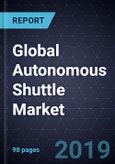Autonomous Shuttles to Constitute 50% of the DRT Market; Cost Considerations, Fleet Efficiency, and Wide-Ranging Use Cases as the Key Driving Forces
The advent of new mobility services such as carsharing, bikesharing, ridesharing, ride hailing, and demand responsive transit (DRT) has brought the concept of shared mobility to center stage. Growing environmental concerns, congestion, lack of parking, vertical expansion in most emerging cities, and smart city initiatives have spearheaded a new revolution in mobility - from single occupancy (ride hailing) to multiple occupancy shared mobility (ride sharing, DRT).
Advanced technology platforms are being leveraged that help improve fleet optimization and precise fleet sizing across all mobility modes. Autonomous mobility services are emerging as an amalgamation of all possible solutions to urban mobility issues - highly efficient fleets that operate for more than 20 hours in a day, shared mobility services, compact vehicles, and limited number of active vehicles on the roads.
This study analyzes the emerging autonomous shuttle mobility market from different perspectives - stakeholder ecosystem and the growing significance of OEMs, autonomous startups, technology platforms and cities, regulatory outlook and commercialization potential, possible business and revenue models, cost comparisons, the importance of data and data sharing, and the global market outlook. Autonomous vehicle designing, parking, maintenance and repair, and insurance are some of the key markets that are expected to be disrupted by the advent of autonomous shuttles.
While commercialization in developed markets is expected by 2019, commercial autonomous shuttle services are expected post-2021 in emerging markets. Commercialization, however, will require substantial capital investment due to factors such as low awareness, low utilization rates, and high initial capital outlay for operations. Government funding will play a critical role in determining success for the market. Cities and transit agencies will be instrumental in implementing the services - integrating autonomous shuttle into the public transit system. Determining proper use cases and deploying the shuttles accordingly will lead to higher adoption and uptake rates. The current use case typically includes last mile connectivity; however, it can be expanded to suit a wide range of mobility requirements across geofenced and non-geofenced operations - in the short run, autonomous shuttles are expected to continue being geofenced and supervised. In the mid to long term, autonomous shuttles will gradually move towards being unsupervised and will operate on non-geofenced routes.
The autonomous shuttle market is currently dominated by vehicle manufacturers and technology platforms such as Easymile, Navya, Aptiv, May Mobility, Bestmile, Oxbotica, and Sensible 4. However, it is expected that all service providers will move towards becoming a platform - controlling every part of the value chain.
As the market evolves, new business models such as autonomous delivery and logistics services are expected to gain significance. A number of pilots, including pilots by OEMs such as Ford and GM, are being undertaken for autonomous deliveries.
With robust market potential and growth trajectory, the autonomous shuttle market is expected to constitute 50% of the demand responsive transit market by 2030.
Table of Contents
Companies Mentioned (Partial List)
A selection of companies mentioned in this report includes, but is not limited to:
- Aptiv
- Bestmile
- Easymile
- Ford
- GM
- May Mobility
- Navya
- Oxbotica
- Postbus
- Ridecell
- Sensible 4
- Transdev








